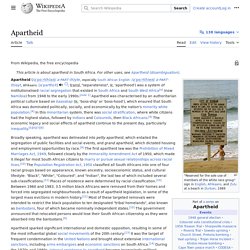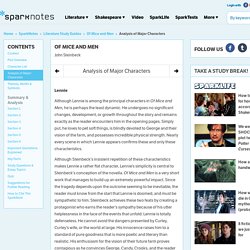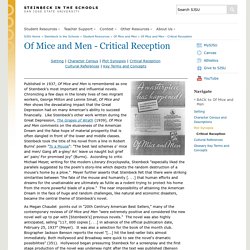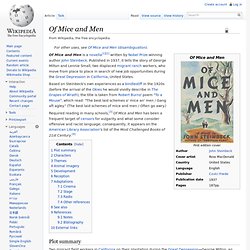

Apartheid - Facts & Summary. In 1976, when thousands of black children in Soweto, a black township outside Johannesburg, demonstrated against the Afrikaans language requirement for black African students, the police opened fire with tear gas and bullets.

The protests and government crackdowns that followed, combined with a national economic recession, drew more international attention to South Africa and shattered all illusions that apartheid had brought peace or prosperity to the nation. Of Mice and Men: Steinbeck's Of Mice and Men. John Steinbeck's Of Mice and Men is a parable about what it means to be human.

Steinbeck's story of George and Lennie's ambition of owning their own ranch, and the obstacles that stand in the way of that ambition, reveal the nature of dreams, dignity, loneliness, and sacrifice. Ultimately, Lennie, the mentally handicapped giant who makes George's dream of owning his own ranch worthwhile, ironically becomes the greatest obstacle to achieving that dream. Written by: John Steinbeck Type of Work: novel Genres: parable; Great Depression First Published: 1937 Setting: a ranch Main Characters: George Milton; Lennie Small; Candy; Curley; Curley's wife; Slim; Crooks.
Apartheid. System of institutionalised racial segregation that existed in South Africa and South West Africa (Namibia) from 1948 until the early 1990s Apartheid (South African English: ; Afrikaans: [aˈpartɦɛit], segregation; lit.

"aparthood") was a system of institutionalised racial segregation that existed in South Africa and South West Africa (now Namibia) from 1948 until the early 1990s. [note 1] Apartheid was characterised by an authoritarian political culture based on baasskap (or white supremacy), which ensured that South Africa was dominated politically, socially, and economically by the nation's minority white population.[4] According to this system of social stratification, white citizens had the highest status, followed by Asians and Coloureds, then black Africans.[4] The economic legacy and social effects of apartheid continue to the present day.[5][6][7] Etymology[edit] Precursors[edit] The Great Depression - Facts & Summary.
Hoover, a Republican who had formerly served as U.S. secretary of commerce, believed that government should not directly intervene in the economy, and that it did not have the responsibility to create jobs or provide economic relief for its citizens.

In 1932, however, with the country mired in the depths of the Great Depression and some 15 million people (more than 20 percent of the U.S. population at the time) unemployed, Democrat Franklin D. Roosevelt won an overwhelming victory in the presidential election. By Inauguration Day (March 4, 1933), every U.S. state had ordered all remaining banks to close at the end of the fourth wave of banking panics, and the U.S. Treasury didn’t have enough cash to pay all government workers. Nonetheless, FDR (as he was known) projected a calm energy and optimism, famously declaring that “the only thing we have to fear is fear itself.” 15 Things You Might Not Know About 'Of Mice and Men' You probably spent some time as a teenager reading John Steinbeck’s novella Of Mice and Men.

Even if you know about Lennie and George’s heartbreaking pursuit of life, liberty, and a hutch full of rabbits, there are a few things you might have missed about the iconic story during English class. Although he was a Stanford University graduate and had published five books by the time he wrote Of Mice and Men, Steinbeck had more in common with his itinerant main characters than readers might have expected.
“I was a bindle-stiff myself for quite a spell,” the author told The New York Times in 1937, employing the now archaic nickname for migrant workers. Of Mice and Men by John Steinbeck - review. Of Mice and Men is a well-known classic, and with valid reason.

The book may seem rather boring (as many books about the Great Depression may seem) but it is actually a great tribute to literature. The book is about a man called George and his childlike, kind-hearted friend Lennie. They find work in a ranch after being on the run from their old job because Lennie got them in deep trouble, and it seems that in this book he may get in trouble again as George may have not been able to help him. The book is great because, not only the great use of description, but the characters because Steinbeck shows how children are, in some cases, better people than adults in the way that they do not judge people because they do not see people or things from that point of view (an example being childlike Lennie who has a mental disability though they didn't know that at the time the book is based).
Want to tell the world about a book you've read? Of Mice and Men: Analysis of Major Characters. Lennie Although Lennie is among the principal characters in Of Mice and Men, he is perhaps the least dynamic.

He undergoes no significant changes, development, or growth throughout the story and remains exactly as the reader encounters him in the opening pages. Simply put, he loves to pet soft things, is blindly devoted to George and their vision of the farm, and possesses incredible physical strength. Nearly every scene in which Lennie appears confirms these and only these characteristics. Although Steinbeck’s insistent repetition of these characteristics makes Lennie a rather flat character, Lennie’s simplicity is central to Steinbeck’s conception of the novella.
GCSE Bitesize: Why was there so much racial inequality in the USA between 1929 and 1945? Of Mice and Men - Critical Reception. Setting | Character Census | Plot Synopsis | Critical ReceptionCultural References | Key Terms and Concepts.

Of Mice and Men. Of Mice and Men is a novella[1][2] written by Nobel Prize-winning author John Steinbeck.

Published in 1937, it tells the story of George Milton and Lennie Small, two displaced migrant ranch workers, who move from place to place in search of new job opportunities during the Great Depression in California, United States. Based on Steinbeck's own experiences as a bindlestiff in the 1920s (before the arrival of the Okies he would vividly describe in The Grapes of Wrath), the title is taken from Robert Burns' poem "To a Mouse", which read: "The best laid schemes o' mice an' men / Gang aft agley. "